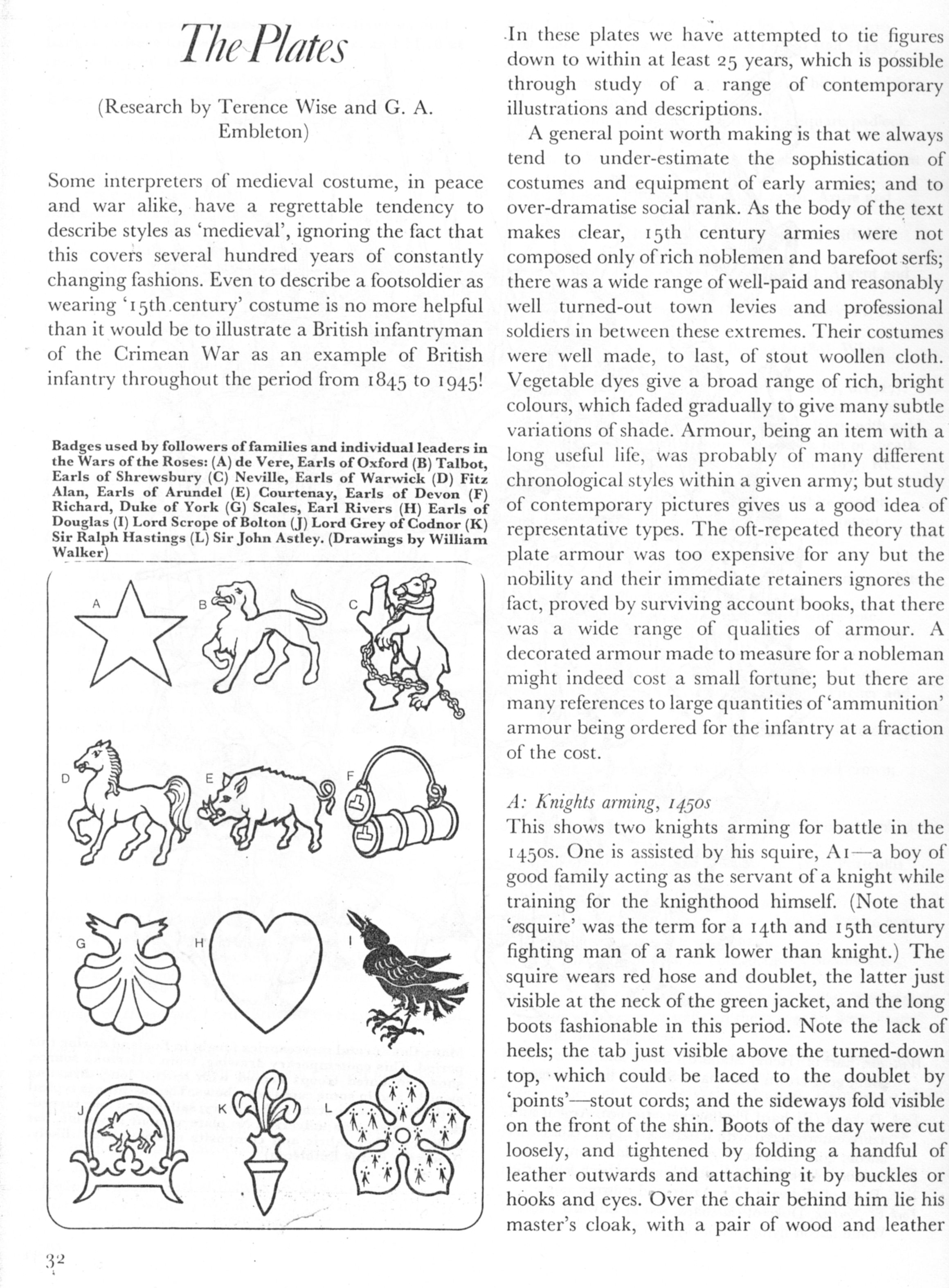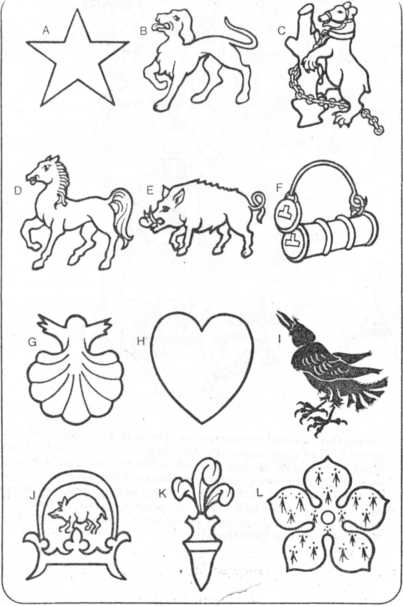53258 m1452

ThePlates
(Research by Tcrence Wise and G. A.
Embleton)
Some interpreters of medieval costume, in peace and war alike, have a regrettable tendency to describe styles as ‘medieyal’, ignoring the fact that tliis covers several hundred years of constantly changing fashions. Even to describe a footsoldier as wearing Ł15th century’ costume is no morę helpful than it would be to illustrate a British infantryman of the Crimean War as an example of British infantry throughout the period from 1845 to 1945!
Badgcs used by followers of families and individual lcaders in the Wars of the Roses: (A) de Vcre, Earls of Oxford (B) Talbot, Earls of Shrewsbury (C) Neville, Earls of Warwick (D) Fitz Alan, Earls of Arundel (E) Courtenay, Earls of Devon (F) Richard, Duke of York (G) Scales, Earl Rivers (H) Earls of Douglas (I) Lord Scrope of Bolton (J) Lord Grey of Codnor (K) Sir Ralph Hastings (L) Sir John Astley. (Drawings by William Walker]_ _____

In these plates we have attempted to tie figures down to within at least 25 years, which is possible through study of a rangę of contemporary illustrations and descriptions.
A generał point worth making is that we always tend to undcr-estimate the sophistication of costumes and eąuipment of early armies; and to over-dramatise social rank. As the body of the text makes elear, 15th century armies were not composed only of rich noblemen and barefoot serfs; there was a wide rangę ofwell-paid and reasonably well turned-out town levies and professional soldiers in bctwcen these extrcmes. Their costumes were well madę, to last, of stout woollen cloth. Vegetable dyes give a broacl rangę of rich, bright colours, which faded gradually to give many subtle variations of shade. Armour, being an item with a long useful life, was probably of many dilferent chronological styles within a given army; but study of contemporary pictures gives us a good idea of representative types. The oft-repeated theory that piąte armour was too expensive for any but the nobility and their immediate retainers ignores the fact, proved by surviving account books, that there was a wide rangę of qualities of armour. A decorated armour madę to measure for a nobleman might indeed cost a smali fortunę; but there are many references to large quantities of‘ammunition’ armour being ordered for the infantry at a fraction of the cost.
A: Knights arming, 1450S
This shows two knights arming for battle in the 1450S. One is assisted by his squire, Ai—a boy of good family acting as the servant of a knight while training for the knighthood himself. (Notę that ‘ćsquire’ was the term for a I4th and 15th century fighting man of a rank lower than knight.) The squire wears red hose and doublet, the latter just visible at the neck of the green jacket, and the long boots fashionable in this period. Notę the lack of heels; the tab just visible above the turned-down top, which could be laced to the doublet by ‘points’—stout cords; and the sideways fold visible on the front of the shin. Boots of the day were cut loosely, and tightened by folding a handful of leather outwards and attaching it by buckles or hooks and eyes. Over the chair behind him lie his master’s cloak, with a pair of wood and leather
Wyszukiwarka
Podobne podstrony:
192 STRESS ANALYSIS Some features of the behaviour in bending of thin-walled tubes and channels, by
strange combination of traditional European clothing and Native American dress, she is struck by his
00104 U22672e84810718d615778de2b5b475 103 The OCAP benefits are experienced by production superviso
"(Thompson] morę than holds h^r o territory blazed by Tami Hoag and Tess Gerritsen.” -Publ
© Copyright by Marek Kwiatkowski and Piotr Stepnowski Skład komputerowy: Marek Kwiatkowski Redakcja
Download Je bent die je bent (en dat ben je) PDF eBooks Free window, document);, by debnet Laugh and
Download Biología, 1 (Libros de Texto) (Spanish Edition) PDF eBooks Free Love by Huey Lew
99. B.96796 THE FUTURĘ of public employee retirement systems / ed. by 01ivia S. Mi
27. B.96907 CENTRAL bank management / ed. by John Mendzela and Nick Carver ; [with
44. A.69475 DESIGNING the European model / ed. by Seppo Honkapohja and Frank Weste
więcej podobnych podstron